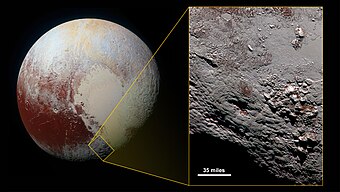Geology of Pluto
This articleis missing informationabout More recent geological work about Pluto's ridge-trough system, true polar wander, and tectonics.(September 2024) |

Thegeology of Plutoconsists of the characteristics of the surface, crust, and interior ofPluto.Because of Pluto's distance from Earth, in-depth study from Earth is difficult. Many details about Pluto remained unknown until 14 July 2015, whenNew Horizonsflew through the Pluto system and began transmitting data back to Earth.[1]When it did, Pluto was found to have remarkable geologic diversity, withNew Horizonsteam member Jeff Moore saying that it "is every bit as complex as that of Mars".[2]The finalNew HorizonsPluto data transmission was received on 25 October 2016.[3][4]In June 2020, astronomers reported evidence that Pluto may have had asubsurface ocean,and consequently may have beenhabitable,when it was first formed.[5][6]
Surface
[edit]
(11 July 2015)
More than 98 percent of Pluto's surface consists ofsolid nitrogen,with traces ofmethaneandcarbon monoxide.[7]The face of Pluto oriented toward Charon contains more solid methane,[8]whereas the opposite face contains more nitrogen and solid carbon monoxide.[9]Distribution of volatile ices is thought to be season-dependent and influenced more by solar insolation and topography than by subsurface processes.[10][8]
Maps produced from images taken by theHubble Space Telescope(HST), together with Pluto's light curve and the periodic variations in its infrared spectra, indicate that Pluto's surface is very varied, with large differences in both brightness and color,[11]with albedos between 0.49 and 0.66.[12]Pluto is one of the most contrastive bodies in the Solar System, with as much contrast asSaturn's moonIapetus.[13]The color varies between charcoal black, dark orange and white.[14]New Horizonsdata suggest equally variable surface ages for Pluto, with ancient, dark, mountainous terrain occurring alongside the bright, flat, effectively craterless Sputnik Planitia and various terrains of intermediate age and color.
Pluto's surface color changed between 1994 and 2003: the northern polar region brightened and the southern hemisphere darkened.[14]Pluto's overall redness also increased substantially between 2000 and 2002.[14]These rapid changes probably relate to seasonal condensation andsublimationof portions of Pluto'satmosphere,amplified by Pluto's extremeaxial tiltand highorbital eccentricity.[14]
-
The portions of Pluto's surface mapped byNew Horizons.Center is 180 degrees longitude (diametrically opposite the moon Charon).
-
Distribution of over 1000 craters of all ages on Pluto. The variation in density indicates a long history of varying geological activity.
-
Geologic map of Sputnik Planitia and surroundings (context), with convection cell margins outlined in black
Soft-ice plains and glaciers
[edit]Sputnik Planitiaappears to be composed of ices more volatile, softer and more dense than the water-ice bedrock of Pluto, includingnitrogen,carbon monoxide and solid methane.[15]A polygonalconvection cellstructure is visible over much of the planitia. No craters have been found, indicating that its surface must be less than 10 million years old.[16]A number of mechanisms are proposed to explain the absence of craters, includingcryovolcanism(volcanoes eruptingvolatilesinstead of magma), convective overturn, andviscousrelaxation – processes that would erase negative topography.[16]Glaciers of what is probably solid nitrogen can be seen flowing from the planitia into adjacent depressions and craters. Nitrogen from the plain appears to have been carried via the atmosphere and deposited in a thin layer of ice on uplands to the east and south of the plain, forming the large bright eastern lobe ofTombaugh Regio.Glaciers appear to be flowing back into the planitia through valleys from these eastern highlands.
-
Nitrogen ice glaciers flowing into the eastern margin of the planitia (similar reprojected backlit view highlighting flow lines).
Water-ice mountains
[edit]Mountains several kilometres high occur along the southwestern and southern edges of Sputnik Planitia. Water ice is the only ice detected on Pluto that is strong enough at Plutonian temperatures to support such heights.
-
Pluto - water ice distribution (false color; rel 29 January 2016)
-
Regions where water ice has been detected (blue regions)
-
Hillary MontesandTenzing Montes(labeled Norgay Montes) lie between Sputnik Planitia (top) and Belton Regio (bottom).[18]
Ancient cratered terrain
[edit]Belton Regioandother dark areashave many craters and signatures of solid methane. The dark red color is thought to be due totholinsfalling out of Pluto's atmosphere.
Northern latitudes
[edit]The mid-northern latitudes display a variety of terrain reminiscent of the surface ofTriton.A polar cap consisting of solid methane "diluted in a thick, transparent slab of solid nitrogen" is somewhat darker and redder.[19]
-
Distribution of methane ice on Pluto.[8]Bright green is the polar cap; bright red isHarrington Regio.
-
Map of methane ice abundance, which shows striking regional differences.[8]Stronger methane absorption indicated by the brighter purple colors here, and lower abundances shown in black.
-
Indications of complex geological features north of the dark equatorial regions
Tartarus Dorsa
[edit]
The western part of Pluto's northern hemisphere consists of an extensive, highly distinctive set of 500-meter-high mountains informally named Tartarus Dorsa; the spacing and shape of the mountains looks similar to scales or to tree bark. A January 2017Naturepaper by Dr. John Moores and his colleagues identified these icy ridges aspenitentes.[20]Penitentes are icy depressions formed by erosion and surrounded by tall spires. Pluto is the only planetary body other than Earth on which penitentes have been identified. Although penitentes have been hypothesized on Jupiter's satelliteEuropa,current theories suggest they may require an atmosphere to form. Moores and his colleagues hypothesize that Pluto's penitentes grow only during periods of high atmospheric pressure, at a rate of approximately 1 centimeter per orbital cycle. These penitentes appear to have formed in the last few tens-of-millions of years, an idea supported by the sparsity of craters in the region, making Tartarus Dorsa one of the youngest regions on Pluto.[20]
Cutting through both Tartarus Dorsa and Pluto's heavily cratered northern terrain (and thus formed more recently than both) is a set of six canyons radiating from a single point; the longest, informally named Sleipnir Fossa, is over 580 kilometers long. These chasms are thought to have originated from pressures caused by material upwelling at the center of the formation.[21]
Possible cryovolcanism
[edit]WhenNew Horizonsfirst sent back data from Pluto, Pluto was thought[by whom?]to be losing hundreds of tons of its atmosphere an hour to ultraviolet light from the Sun; such an escape rate would be too great to be resupplied by comet impacts. Instead, nitrogen was thought to be resupplied either bycryovolcanismor by geysers bringing it to the surface. Images of structures that imply upwelling of material from within Pluto, and streaks possibly left by geysers, support this view.[17][22]Subsequent discoveries suggest that Pluto's atmospheric escape was overestimated by several thousand times and thus Pluto could theoretically keep its atmosphere without geological assistance, though evidence of ongoing geology remains strong.[23]
Two possible cryovolcanoes,Wright MonsandPiccard Mons,have been identified in topographic maps of the region south ofSputnik Planitia,near the south pole. Both are over 150 km across and at least 4 km high, the tallest peaks known on Pluto at present. They are lightly cratered and thus geologically young, although not as young as Sputnik Planitia. They are characterized by a large summit depression and hummocky flanks. This represents the first time large potentially cryovolcanic constructs have been clearly imaged anywhere in the Solar System.[24][25][26]
A 2019 study identified a second likely cryovolcanic structure around Virgil Fossae, a series of troughs in northeastern Belton Regio, west of Tombaugh Regio. Ammonia-rich cryolavas appear to have erupted from Virgil Fossae and several nearby sites and covered an area of several thousand square kilometers; the fact that the ammonia's spectral signal was detectable when New Horizons flew by Pluto suggests that Virgil Fossae is no older than one billion years and potentially far younger, as galactic cosmic rays would destroy all the ammonia in the upper meter of the crust in that time and solar radiation could destroy the surface ammonia 10 to 10000 times more quickly. The subsurface reservoir from which this cryomagma emerged may have been separate from Pluto's subsurface ocean.[27]
Internal structure
[edit]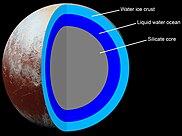
- Water ice crust
- Liquid water ocean
- Silicate core
Pluto's density is1.87 g/cm3.[29]Because thedecay of radioactive elementswould eventually heat the ices enough for the rock to separate from them, scientists think that Pluto's internal structure is differentiated, with the rocky material having settled into a densecoresurrounded by amantleof water ice.[30]Pluto's abundant surface volatiles imply that Pluto is either completely differentiated (and thus has liberated all of the volatiles that had been locked away in its water ice) or formed within less than a million years after the circumstellar disk was cleared (when volatiles were still available to be incorporated into Pluto).[31]
The diameter of the core is hypothesized to be approximately1700 km,70% of Pluto's diameter.[28]It is possible that such heating continues today, creating a subsurfaceocean layerof liquid water and ammonia some100 to 180 kmthick at the core–mantle boundary.[28][30][32]Studies based onNew Horizon's images of Pluto reveal no signs of contraction (as would be expected if Pluto's internal water had all frozen and turned intoice II) and imply that Pluto's interior is still expanding, probably due to this internal ocean; this is the first concrete evidence that Pluto's interior is still liquid.[33][34]Pluto is proposed to have a thick water-icelithosphere,based on the length of individual faults and lack of localized uplift. Differing trends in the faults suggest previously active tectonics, though its mechanisms remain unknown.[35]TheDLRInstitute of Planetary Researchcalculated that Pluto's density-to-radius ratio lies in a transition zone, along with Neptune's moonTriton,between icy satellites like the mid-sizedmoons of UranusandSaturn,and rocky satellites such as Jupiter'sIo.[36]
Pluto has no magnetic field.[37]
See also
[edit]References
[edit]- ^ Brown, Dwayne; Buckley, Michael; Stothoff, Maria (15 January 2015)."January 15, 2015 Release 15-011 - NASA's New Horizons Spacecraft Begins First Stages of Pluto Encounter".NASA.Retrieved15 January2015.
- ^"New Pluto images from NASA's New Horizons show complex terrain".Astronomy. 10 September 2015.Retrieved29 June2018.
- ^Chang, Kenneth (28 October 2016)."No More Data From Pluto".The New York Times.Retrieved3 December2016.
- ^"Pluto Exploration Complete: New Horizons Returns Last Bits of 2015 Flyby Data to Earth".Johns Hopkins Applied Research Laboratory. 27 October 2016.Retrieved3 December2016.
- ^Rabie, Passant (22 June 2020)."New Evidence Suggests Something Strange and Surprising about Pluto - The findings will make scientists rethink the habitability of Kuiper Belt objects".Inverse.Retrieved23 June2020.
- ^Bierson, Carver; et al. (22 June 2020)."Evidence for a hot start and early ocean formation on Pluto".Nature Geoscience.769(7): 468–472.Bibcode:2020NatGe..13..468B.doi:10.1038/s41561-020-0595-0.S2CID219976751.Retrieved23 June2020.
- ^ Owen, Tobias C.; Roush, Ted L.; Cruikshank, Dale P.; et al. (1993). "Surface Ices and the Atmospheric Composition of Pluto".Science.261(5122): 745–748.Bibcode:1993Sci...261..745O.doi:10.1126/science.261.5122.745.JSTOR2882241.PMID17757212.S2CID6039266.
- ^abcdLewin, Sarah (27 September 2017)."Pluto's 'Skyscrapers': What's Responsible for Dwarf Planet's Giant Ice Blades".Space.Retrieved27 September2017.
- ^ Boyle, Alan (11 February 1999)."Pluto regains its place on the fringe".NBC News. Archived fromthe originalon 5 November 2013.Retrieved20 March2007.
- ^Bertrand, Tanguy; Forget, François (19 September 2016). "Observed glacier and volatile distribution on Pluto from atmosphere–topography processes".Nature.540(7631): 86–89.Bibcode:2016Natur.540...86B.doi:10.1038/nature19337.PMID27629517.S2CID4401893.
- ^ Buie, Marc W.; Grundy, William M.; Young, Eliot F.; et al. (2010)."Pluto and Charon with the Hubble Space Telescope: I. Monitoring global change and improved surface properties from light curves".Astronomical Journal.139(3): 1117–1127.Bibcode:2010AJ....139.1117B.CiteSeerX10.1.1.625.7795.doi:10.1088/0004-6256/139/3/1117.S2CID1725219.
- ^ Hamilton, Calvin J. (12 February 2006)."Dwarf Planet Pluto".Views of the Solar System.Retrieved10 January2007.
- ^ Buie, Marc W."Pluto map information".Archived fromthe originalon 29 June 2011.Retrieved10 February2010.
- ^abcd Villard, Ray; Buie, Marc W. (4 February 2010)."New Hubble Maps of Pluto Show Surface Changes".News Release Number: STScI-2010-06.Retrieved10 February2010.
- ^Lakdawalla, Emily(21 December 2015)."Pluto updates from AGU and DPS: Pretty pictures from a confusing world".The Planetary Society.Retrieved24 January2016.
- ^abMarchis, F.; Trilling, D. E. (20 January 2016)."The Surface Age of Sputnik Planum, Pluto, Must Be Less than 10 Million Years".PLOS ONE.11(1): e0147386.arXiv:1601.02833.Bibcode:2016PLoSO..1147386T.doi:10.1371/journal.pone.0147386.PMC4720356.PMID26790001.
- ^abChang, Kenneth (17 July 2015)."Pluto terrain yields big surprises in New Horizons images".The New York Times.Retrieved17 July2015.
- ^Gipson, Lillian (24 July 2015)."New Horizons Discovers Flowing Ices on Pluto".NASA.Archived fromthe originalon 17 March 2016.Retrieved24 July2015.
- ^"Solar System Exploration: Multimedia: Gallery: Planetary Images: Pluto: The Ice Plot Thickens".NASA. Archived fromthe originalon 18 August 2015.Retrieved11 August2015.
- ^abMoores, John E.; Smith, Christina L.; Toigo, Anthony D.; Guzewich, Scott D. (4 January 2017). "Penitentes as the origin of the bladed terrain of Tartarus Dorsa on Pluto".Nature.541(7636): 188–190.arXiv:1707.06670.Bibcode:2017Natur.541..188M.doi:10.1038/nature20779.PMID28052055.S2CID4388677.
- ^Talbert, Tricia, ed. (8 April 2016)."Icy 'Spider' on Pluto".NASA. Archived fromthe originalon 21 March 2023.Retrieved23 February2017.
- ^"Scientists study nitrogen provision for Pluto's atmosphere".phys.org. 11 August 2015.Retrieved11 August2015.
- ^"New Horizons: News Article?page=20151109".
- ^"At Pluto, New Horizons Finds Geology of All Ages, Possible Ice Volcanoes, Insight into Planetary Origins".New Horizons News Center.The Johns Hopkins University Applied Physics Laboratory LLC. 9 November 2015.Retrieved9 November2015.
- ^Witze, A. (9 November 2015)."Icy volcanoes may dot Pluto's surface".Nature.doi:10.1038/nature.2015.18756.S2CID182698872.Retrieved9 November2015.
- ^Redd, N. T. (9 November 2015)."Icy Volcanoes May Erupt on Pluto".Space.Com.Retrieved10 November2015.
- ^Cruikshank, Dale P.; Umurhan, Orkan M.; Beyer, Ross A.; Schmitt, Bernard; Keane, James T.; Runyon, Kirby D.; Atri, Dimitra; White, Oliver L.; Matsuyama, Isamu; Moore, Jeffrey M.; McKinnon, William B.; Sandford, Scott A.; Singer, Kelsi N.; Grundy, William M.;Dalle Ore, Cristina M.;Cook, Jason C.; Bertrand, Tanguy; Stern, S. Alan; Olkin, Catherine B.; Weaver, Harold A.; Young, Leslie A.; Spencer, John R.; Lisse, Carey M.; Binzel, Richard P.; Earle, Alissa M.; Robbins, Stuart J.; Gladstone, G. Randall; Cartwright, Richard J.; Ennico, Kimberly (15 September 2019)."Recent cryovolcanism in Virgil Fossae on Pluto".Icarus.330:155–168.Bibcode:2019Icar..330..155C.doi:10.1016/j.icarus.2019.04.023.S2CID149983734.
- ^abc Hussmann, Hauke; Sohl, Frank; Spohn, Tilman (November 2006)."Subsurface oceans and deep interiors of medium-sized outer planet satellites and large trans-neptunian objects".Icarus.185(1): 258–273.Bibcode:2006Icar..185..258H.doi:10.1016/j.icarus.2006.06.005.
- ^Pluto – Universe Today
- ^ab"The Inside Story".pluto.jhuapl.edu – NASA New Horizons mission site.Johns Hopkins University Applied Physics Laboratory. 2007. Archived fromthe originalon 16 May 2008.Retrieved11 July2015.
- ^Lisse, C. M.; Young, L.; Cruikshank, D.; Sandford, S.; Schmitt, B.; Stern, S. A.; Weaver, H. A.; Umurhan, O.; Pendleton, Y.; Keane, J.; Gladstone, R.; Parker, J.; Binzel, R.; Earle, A.; Horanyi, M.; El-Maarry, M.; Cheng, A.; Moore, J.; McKinnon, W.; Grundy, W.; Kavelaars, J. (2020). "Ices in KBO MU69 and Pluto – Implications for Their Formation & Evolution".American Astronomical Society Meeting Abstracts.52:438.04.Bibcode:2020AAS...23543804L.
- ^ "What is Pluto made of?".Space. 20 November 2012.Retrieved11 July2015.
- ^Gearin, Conor (22 June 2016)."Pluto must have liquid ocean or it'd look like an overripe peach".New Scientist.Retrieved23 February2017.
- ^Hammond, Noah P.; Barr, Amy C.; Parmentier, Edgar M. (2 July 2016). "Recent tectonic activity on Pluto driven by phase changes in the ice shell".Geophysical Research Letters.43(13): 6775–6782.arXiv:1606.04840.Bibcode:2016GeoRL..43.6775H.doi:10.1002/2016GL069220.S2CID54219400.
- ^Moore, J. M.; McKinnon, W. B.; Spencer, J. R.; Howard, A. D.; Schenk, P. M.; Beyer, R. A.; Nimmo, F.; Singer, K. N.; Umurhan, O. M.; White, O. L.; et al. (18 March 2016). "The geology of Pluto and Charon through the eyes of New Horizons".Science.351(6279): 1284–1293.arXiv:1604.05702.Bibcode:2016Sci...351.1284M.doi:10.1126/science.aad7055.PMID26989245.S2CID206644622.
- ^DLR Interior Structure of Planetary BodiesArchived26 July 2011 at theWayback MachineDLR Radius to DensityArchived26 July 2011 at theWayback MachineThe natural satellites of the giant outer planets...Archived11 May 2011 at theWayback Machine
- ^NASA (14 September 2016)."X-ray Detection Sheds New Light on Pluto".nasa.gov.Retrieved3 December2016.

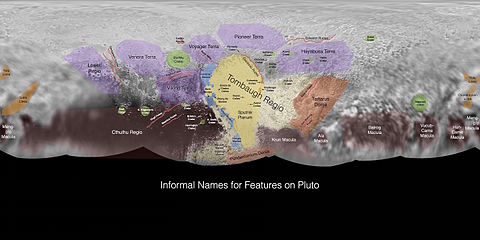


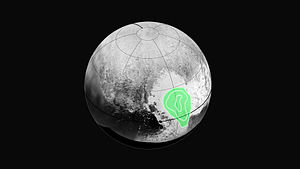




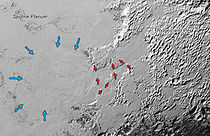
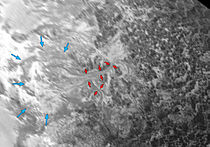


![Hillary Montes and Tenzing Montes (labeled Norgay Montes) lie between Sputnik Planitia (top) and Belton Regio (bottom).[18]](https://upload.wikimedia.org/wikipedia/commons/thumb/a/ad/NH-Pluto-SputnikPlanum-HillaryMontes-NorgayMontes-20150714.jpg/210px-NH-Pluto-SputnikPlanum-HillaryMontes-NorgayMontes-20150714.jpg)
![Distribution of methane ice on Pluto.[8] Bright green is the polar cap; bright red is Harrington Regio.](https://upload.wikimedia.org/wikipedia/commons/thumb/d/d8/NH-Pluto-MethaneIce-20150715.png/210px-NH-Pluto-MethaneIce-20150715.png)
![Map of methane ice abundance, which shows striking regional differences.[8] Stronger methane absorption indicated by the brighter purple colors here, and lower abundances shown in black.](https://upload.wikimedia.org/wikipedia/commons/thumb/9/97/NH-Pluto-MethaneIce-20150924.jpg/210px-NH-Pluto-MethaneIce-20150924.jpg)

